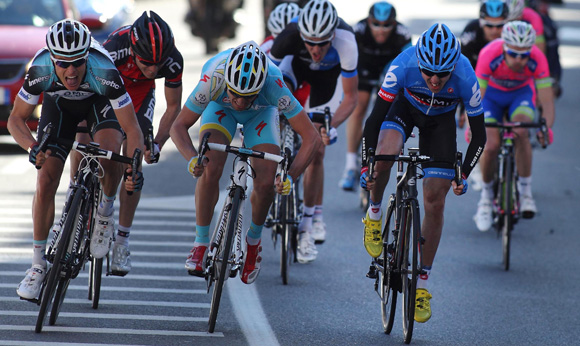Tour of Catalonia: wheelsuckers of the world unite
Gianni Meersman contributed nothing to yesterday’s Tour of Catalonia escape, then outsprinted his rivals to win the stage. Was that fair?
Words by Edward Pickering
Tuesday March 19, 2013

It’s been a good week so far for non-contributing breakaway riders. On Sunday, Gerald Ciolek followed the attacks of more aggressive riders at the end of Milan-San Remo, sat in, then won the race. And yesterday, in stage one of the Tour of Catalonia, Gianni Meersman hitched himself to a 12-strong breakaway of motivated GC riders, sitting conspicuously on the tail of his rivals before jumping past them and winning. (He also took stage two, in a bunch sprint.)
The Tour of Catalonia’s first stage was a clear example of how differing agendas don’t necessarily affect the success of an escape. Omega Pharma rider Meersman was easily the best sprinter there. He was up against nine-stone GC weaklings like Joaquim Rodriguez, Dan Martin, Robert Gesink and Bradley Wiggins, which made him the automatic favourite.
If it had been a one-day race, there’s no way the Belgian would have been allowed to sit on, but in the context of a stage race there were enough strong GC riders to make it worth working together to stay away. Sky and Movistar’s leaders, Wiggins and Alejandro Valverde, each had at least one team-mate in the group, and by putting them to work on the swooping, tailwind-assisted schuss to Calella, they bought themselves a 30-second advantage over rivals who missed the break. The overall race just got a lot simpler.
Let’s look at the 13 riders in the group. Six - Valverde, Martin, WIggins, Gesink, Rodriguez, Michele Scarponi - were GC riders. Four more – David Lopez and Dario Cataldo for Sky, Jesus Herrada for Movistar and Przemyslaw Niemiec for Lampre – were supporting domestiques for Wiggins, Valverde and Scarponi respectively. That left only three others: Meersman, Valerio Agnoli of Astana, and Danilo Wyss of BMC.
The latest race content, interviews, features, reviews and expert buying guides, direct to your inbox!
Behind, Astana were chasing at the head of the peloton, demonstrating that while Agnoli was allowed to sit in and try to win the stage (he sprinted in second), the team’s priority was getting the break back. Wyss is a strong domestique, but after five years and three months as a pro, has yet to win a race. It’s tempting to think that he was happy just to be there. At the speed the break was riding, and the commitment and strength in depth of the riders around him, his only chance of winning – attacking to win solo – was a non-starter. It all added up to Meersman winning, and he did, pretty handily.
But was it fair for Meersman to freewheel to the final 200 metres in the wake of harder-working companions before suddenly waking up? The wheelsucker is one of the least popular personality types in the peloton, and rightly so. Nobody likes a shirker – it's the cycling equivalent of being in a drinks round, but not buying one yourself.
However, in this case, Meersman was absolutely right to do what he did. Among six of the strongest stage racers in the world, the Belgian was never going to figure in the final GC, so his one chance of guaranteeing himself a return from the race was to sit in, gamble that their motivation to stay away was stronger than both the peloton’s will to bring them back and his companions’ irritation that they were towing the eventual recipient of the winner’s bouquet (and the race leader’s jersey, probably for a couple of days), to the finish. He benefited from the work of others, but so did they. Ciolek’s case is more complicated – all Peter Sagan and Fabian Cancellara got from doing the work of breaking away in Milan-San Remo was a sense of regret that they put more into the race than they got out of it.
I also think Meersman deserved his win for other reasons. The first memory I have of him is from the 2008 Tour of Switzerland, when he rode for Française des Jeux. As I watched the race unfold from the top of the Flumserberg (a steady eight-kilometre ramp topped by an extraordinary 400-metre stretch of one-in-four), Meersman attacked from the bottom of the climb. He really went for it, even though as an inexperienced second-year pro he had little chance of holding off more famous riders who were honing their form for the Tour de France. He lasted a couple of kilometres in front before being closed down, his attack a footnote in contemporary race reports, but I remembered the spirit and futility of his enterprise. His only chance of winning on the Flumserberg was if somehow the favourites let him go. His only chance of winning on Monday was to sit in and wheelsuck.
Wheelsucking is a necessary and legitimate tactic in cycling, even if it’s not always a popular one. But most cyclists are in the sport to win races, not friends.
Follow us on Twitter: www.twitter.com/cyclesportmag
Edward Pickering is a writer and journalist, editor of Pro Cycling and previous deputy editor of Cycle Sport. As well as contributing to Cycling Weekly, he has also written for the likes of the New York Times. His book, The Race Against Time, saw him shortlisted for Best New Writer at the British Sports Book Awards. A self-confessed 'fair weather cyclist', Pickering also enjoys running.